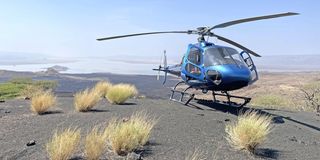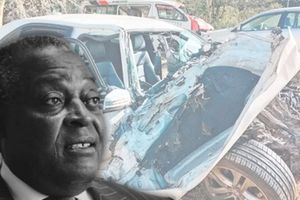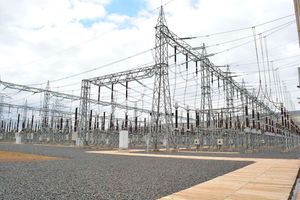Premium
By helicopter through the Mathews Mountain Range

A helicopter on a lava field near Andrews Volcano and the Nabiyotum Crater in Lake Turkana.
We, the Fox family, had spent the night at the Koros Camp in the South Horr Valley. And we had decided to have a leisurely breakfast and a 9.30am take-off in the Tropic Air helicopter piloted by Tats. It would be a return flight to Nanyuki and, like the flight out to Lake Turkana, it would involve a number of landings.
We flew down the South Horr Valley and into the Ndoto Mountains. We landed at the foot of Poi – a massive rock formation, which is a safe home for the endangered Ruppell’s griffon vultures. A Samburu man in traditional dress approached and, after greetings, just stood and watched us and, more likely, our blue helicopter. Well behind him, a young woman watched us more timidly from the shelter of bushes. In the distance, we could see Laisamis on the A2 ‘Great North Road’ and beyond to the flat lands of the Northern Frontier that lead east to places I am more familiar with – the Somali counties of Wajir and Mandera.
After coffees and a photo-shoot at the Poi rock, we flew south over the communities living near the Milgis lugga and cut into the Mathews Range, with its lush, green forests – a massive oasis surrounded by arid plains. We passed palm covered peaks and followed gorges cut into the rocks. Having skimmed the cloud forests, we landed in a glade above the Namunyak section of the range and close to one of the amazing Kenyan Giant Cycads that are endemic to these mountains. They are living fossils of a species that can be traced back as far as 280 million years – making them one of the oldest plant families on our planet. Like the one in the photograph, they have a thick trunk with a crown of stiff, evergreen leaves. They have male and female plants and an unusual system of pollination. The male plants give off a toxic odour that drives out pollen-covered insects that are then attracted by a more pleasant odour that draws them into the female cones.
We flew south and passed Mount Ololokwe near the village of Lerata on the A2. It was the view from the top of this mountain that inspired John Hillaby to make a safari to Lake Rudolf as Lake Turkana was called then. In the book of the safari, ‘Journey to the Jade Sea’ – one of the best travel books I have ever read – he described the northern deserts as having an apocalyptic quality – utterly stark and relieved only by the stumps of worn-out volcanoes. ‘From the top of Lolokwi’ he says, ‘the impression is of an uninhabited hell’. And he made that journey not by helicopter, as we did, not by car, but by walking with camels and wearing tennis shoes.
Carrying on, near Archers Post, we crossed into the Shaba National Reserve. We saw a number of elephants in the shade of trees and, in an open plain, we saw a huge herd of buffalo. Beyond them, we landed on the banks of the Ewaso Nyiro River, near some waterfalls from a spring that was feeding into the main river. For me, it brought back a memory of many years ago when I was staying at Larsen’s Tented Camp, about 30 kilometres upstream and situated near a bend in the river in the Samburu National Reserve. I remember watching a herd of elephants crossing the river very close to the camp, when we were having a sundowner outside our tent. But where we were in Shaba, the only concern was the presence of crocodiles. But the water was so clear and shallow, that a few of our group stripped off and waded to under the water falls.
We took off for the last time and flew in a straight line over Isiolo and with a view of the cinder cones of the Nyambeni Hills to our left. We crossed the Lewa and Borana Conservancies, the flower farms of Timau, and landed at the Nanyuki airstrip. In the two days, we had flown an oval route up to Lake Turkana via the Suguta Valley and then back to Nanyuki via the Mathews Range. It had been an unforgettable safari.
But it was not quite over. We were to spend the night at the Soames Hotel in Nanyuki before driving back to Nairobi. The hotel is named after Jack Soames who had been a farmer at Burguret. He was an active member of the Happy Valley aristocratic crowd in the late 1920s and the 1930s; by many accounts, he was a charmer, party man, hard drinker, philanderer and a voyeur. He would have certainly been a regular member of Jack’s Bar in the Soames Hotel …. But the life of Jack Soames is a story for another time.
The Soames Hotel, with its airy rooms and a manicured garden, after the two days of a very stimulating safari in the heat of northern Kenya, it was a good choice for refreshing showers, good food, a few drinks, reflections on the safari, and a restful night’s sleep before taking the road to Nairobi. I am already missing that small blue helicopter.
John Fox is Chairman of iDC Email: [email protected]





